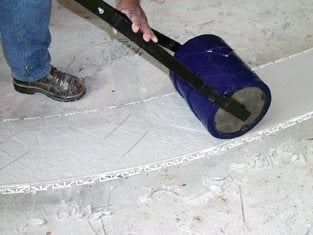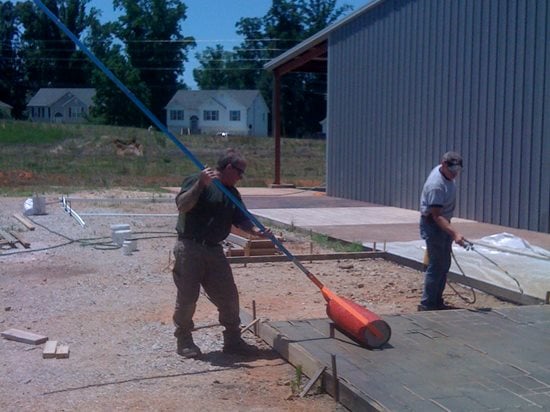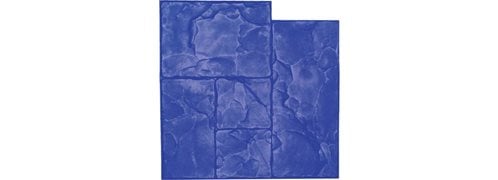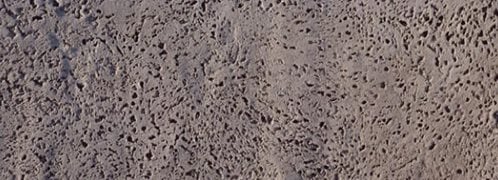- Concrete Stamps
- Get the Look - Stamping Pictures
- Buying Tips for Concrete Stamping Tools: Advice that will help you make smart choices
- Concrete Stamp Cost
- Types of Concrete Stamps: A comparison chart of popular stamps & patterns
- Stamping & Texturing Tools
- Concrete Stamp Mats
- Concrete Texturing Skins
- Medallion Stamps
- Texture Rollers
- Step Forms & Liners
- Installing Stamped Concrete
- How to Stamp Concrete
- Coloring Stamped Concrete
- Concrete Stamp Release Agent
- Sealers for Stamped Concrete
Concrete Stamp Rollers
Tips for buying and using texture rollers to imprint concrete borders and edges
Texture rollers are a speedy way to imprint concrete borders and edges. They come in various lengths and an assortment of brick and stone textures.
Typical applicationsWhen it comes to imprinting borders or bands, concrete stamp rollers are a great way to go. These imprinting tools work best on large-scale projects where detail is not as critical or on long borders, bands and slab edges.
Brain Farnsworth, director of technical services for Bomanite Group International, likes to use texture rollers because of their speed. “You can cover a lot of ground quickly,” he says. Similarly, Brad Walker, owner of Lonestar Decorative Concrete, Watauga, Texas, uses texture rollers to provide a quick imprint along an edge or on a band that stretches across a concrete slab.
Rollers can also be used to simulate a rock salt finish or create a natural looking wood grain. Small, handheld rollers are also useful for vertical concrete work (see Vertical Concrete Stamps & Carving Tools).
One of the most popular applications for texture rollers is on DOT work. They provide a quick and easy method for imprinting concrete highway medians, sidewalks and roadway shoulders, which are typically long, straight runs that don’t require a tremendous amount of detail. The most common patterns for this type of work are running brick and seamless stone, both of which are not negatively affected by a repeating pattern.
How to use a concrete stamp rollerWhen using a texture roller, best practices for concrete stamping still need to be followed, and a release agent is required to keep the roller from sticking to the concrete. It’s important to note that when you use texture rollers, you need to start imprinting earlier than when using standard stamping tools. Because the amount of weight and downward force applied to the roller is limited, texture rollers work best when the concrete is still very soft. If the concrete gets too hard, the depth of imprint can be reduced, resulting in a poorly textured surface.
The other important consideration is to avoid a repeating pattern, which can be an issue when the roller is used across large areas, resulting in lap lines. Because the texture is on a roller and the diameter of the roller is limited, the pattern will repeat every few feet. This is why most texture rollers are used on edge borders or bands where lap lines and repeating patterns are not a factor.
Features to look forThe typical texture roller consists of a plastic or aluminum tube that has a rigid polyurethane-rubber casting on the exterior. The rubber is textured, and when the roller is pulled across green concrete, the texture is transferred into the concrete surface. The first texture rollers were small with limited textures. Today, they are available in various lengths, ranging from 6 inches to more than 4 feet. The number of textures has also expanded greatly, with most common stone textures readily available.

To obtain the best imprint with a texture roller, use the tool on concrete that is very soft and always apply a release agent.
Farnsworth says that the most important thing he looks for in a texture roller is the weight and depth of texture. “Since you are standing to the side, the weight of the roller along with the depth of texture is important to get a good imprint.”
A solid handle that is lightweight and can be easily expanded is another feature to look for. “You can’t always stand right on top of what you are rolling out, so being able to work the roller with a long handle is important,” says Walker.
Texture rollers can be used with either a colored powder release agent or a clear liquid release. The liquid release option is the most popular, and some larger texture rollers have nozzle attachments that spray the liquid release directly on the roller as it’s pulled across the concrete
Return to Concrete Stamps
 Ashlar Cut Slate Stamp
Hand-tooled with a pronounced texture
Ashlar Cut Slate Stamp
Hand-tooled with a pronounced texture
 Herringbone Used Brick
Tool Size is 44" x 27"
Herringbone Used Brick
Tool Size is 44" x 27"
 Travertine Coarse
Groutable
Travertine Coarse
Groutable
 Bluestone Texturing Skin
6 skin set - only $1,173.20
Bluestone Texturing Skin
6 skin set - only $1,173.20
 Five Point Star Medallion
Concrete stamp only - $292.00
Five Point Star Medallion
Concrete stamp only - $292.00
 Brickform Stamping Tools
Precision stamping tools
Brickform Stamping Tools
Precision stamping tools




